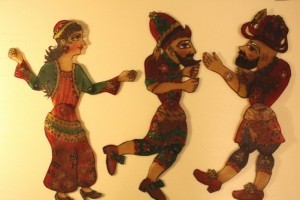
The shadow game known as "Karagöz", which is one of the leading traditional Turkish visual arts in our country, has a history extending to the Far East and India. Evliya Çelebi narrates that the main characters of the play who are Karagöz and Hacivat really lived during the Seljuk period. According to the written sources, shadow puppetry in the Ottomans starts in the 16th century, based on the tradition of Mamluk’s shadow puppetry. The shadow puppetry which is, in fact, a solo show of the puppeteer. The artist designs, cuts, and paints the figures and décor, then controls these puppets while changing his/her sound and expression, and plays them on the white screen that reflects the light. The puppets used in the play are made from camel skin (now generally calf) which has been diligently refined to make it transparent, then they are painted and dried. Since the puppets have joints, their arms and legs are moved in the curtain with one or two sticks placed in the appropriate parts. In addition to the unchanging main characters of the game, many characters like women, men, teenagers, and people from different religions and nations, and also extraordinary creatures are developed over time.




